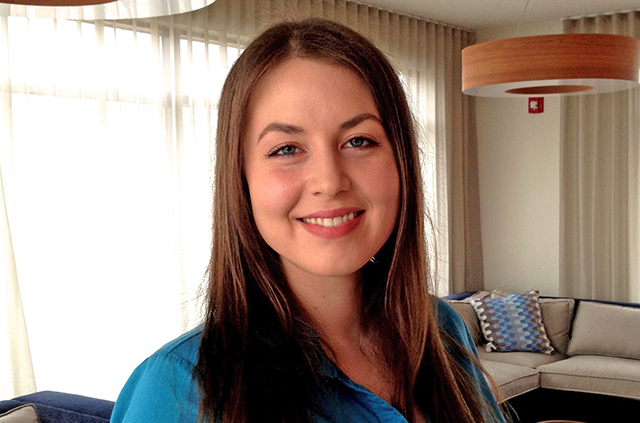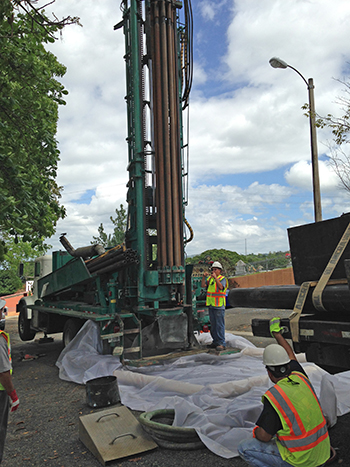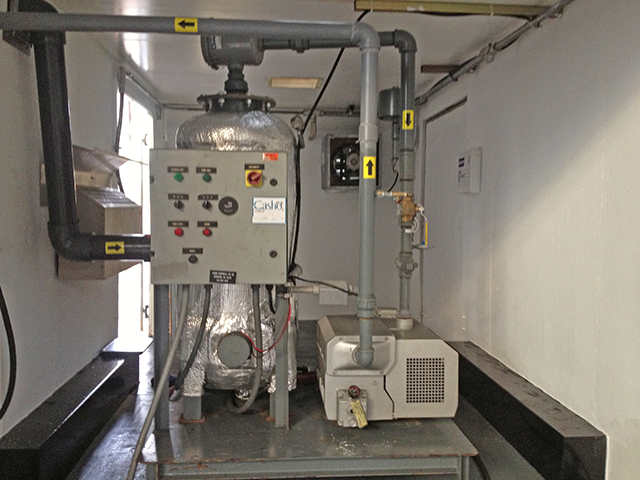Remediation engineer gives new life to contaminated sites
Many would dismiss the scraggly, knee-high grass and rusted shells of former processing facilities that are scattered across an abandoned industrial site as nothing more than a blighted eyesore.
But alumna Jessica Yeager, S.B. ’08, sees that derelict property as what it could be, an opportunity for environmental remediation and economic redevelopment. Yeager, senior engineer at Geosyntec Consultants, manages the cleanup of contaminated sites that are targeted for revitalization.
“Being able to see, in a few short years, a vacant property that is really an eyesore and not providing any economic benefit turned into a productive commercial or residential property is really exciting,” said Yeager.

She has harbored a passion for improving the environment since her childhood in Kansas City. Yeager worked at a local recycling center as a youth and started a club in high school to spearhead sustainability initiatives, including the launch of a school-wide recycling program.
“Those weren’t earth-shattering, change-the-world kinds of things, but those experiences definitely colored the type of contribution I wanted to make with my career,” she said.
An introduction to environmental engineering course at the Harvard John A. Paulson School of Engineering and Applied Sciences convinced Yeager to pursue a concentration in the field. She enjoyed its multidisciplinary nature, which involves intricate analytical work, including chemistry, geology, and hydrology, and requires one to convey sometimes technical content to a wide range of stakeholders, such as business leaders, members of the public, and government officials.
Yeager put her environmental engineering skills to the test during a month-long research trip to Sao Paulo, Brazil, funded by a grant from the Harvard Center for the Environment. She examined the sustainability of ethanol production in the country, the world’s second largest producer of ethanol fuel. As her senior thesis project, Yeager developed a website comparing performance indicators of ethanol produced by different Brazilian firms.
 After earning a master’s degree in environmental engineering at MIT, Yeager joined GZA GeoEnvironmental as a remediation engineer, working with industrial clients to clean up and manage contaminated sties. Her work took her to sites across the country, from Southern California to Nebraska, and even to Puerto Rico, where she managed everything from human health risk assessments to remediation system design and implementation.
After earning a master’s degree in environmental engineering at MIT, Yeager joined GZA GeoEnvironmental as a remediation engineer, working with industrial clients to clean up and manage contaminated sties. Her work took her to sites across the country, from Southern California to Nebraska, and even to Puerto Rico, where she managed everything from human health risk assessments to remediation system design and implementation.
“What I love about environmental engineering consulting is being able to feel like you are really contributing, not only to the success of your client, but also to the productivity of the neighborhood,” she said.
Now as a senior engineer with Geosyntec, Yeager continues to manage brownfield remediation projects throughout Massachusetts. The projects are extremely complex, and the first steps often involve a detailed site assessment to determine if it makes sense for the client to purchase the property.
Developing and implementing a remediation plan, while keeping to a tight construction schedule and working around many subcontractors on an active construction site, all the while adhering to a lengthy list of state and federal regulations, is akin to a frenzied juggling act, Yeager said.
“There is not just one path to cleaning up a site. There are many,” she said. “You need to make sure you are adequately addressing all of the risks to human health and the environment, but making sure that it is still financially viable redevelopment, because otherwise it is not going to happen.”
Yeager especially enjoys the opportunity to work with cutting-edge engineering technologies during remediation. For instance, one project involved the use of electrical resistive heating to remove chemicals from soil. Her team inserted probes into the ground, which emit electricity to increase the ground temperature and boil off hazardous chemicals. They then captured that vapor and treated the contaminants.

The image direclty above shows a dual phase extraction system trailer used for a pilot test at a brownfield site in Boston's Allston neighborhood. The image above left shows a drill rig installing a monitoring well in Oklahoma. (Photos provided by Jessica Yeager)
At another site, Yeager used bacteria to clean up groundwater contamination. These particular bacteria consumed the contaminant during respiration, so by injecting the microorganisms and a food source into the ground, the team removed the contamination using natural processes.
Depending on the amount and type of contamination, remediation projects can come to fruition in a few years or more than a decade.
Each site presents its own set of unique challenges and Yeager, a problem-solver at heart, feels energized as she seeks the best solutions for both her client and the environment.
“It is very unusual to be able to have such a concrete impact on the environment. We all do our part, recycling our cans or turning off lights, and we feel like we are doing something to improve the environment,” she said. “But to actually look at a site and to know that the groundwater or the soil there is cleaner because you contributed is really rewarding.”